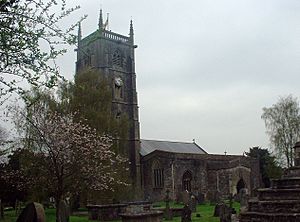St Andrew's Church, Chew Magna facts for kids
Quick facts for kids Church of St Andrew |
|
|---|---|
 |
|
| Location | Chew Magna, Somerset, England |
| Built | 12th century |
|
Listed Building – Grade I
|
|
| Designated | 21 September 1960 |
| Reference no. | 1129613 |
| Lua error in Module:Location_map at line 420: attempt to index field 'wikibase' (a nil value). | |
The Church of St Andrew is a very old church in Chew Magna, Somerset, England. It was first built in the 1100s. It has a tall tower from the 1400s. This tower has pointy tops called pinnacles. Inside, you can see a special font from the Norman times. There's also a rood screen that stretches across the whole church. This church is so important that it's a Grade I listed building. This means it's a very special historic building.
Contents
History of St Andrew's Church
The church was made new again in 1860. Its records, called a register, go all the way back to 1562. The church tower is about 100 feet (30 meters) tall. It was probably built around the year 1440.
Church Bells and Clock
There has been a clock on the tower since the early 1700s. The tower holds eight bells. The biggest bell weighs about 28 hundredweight, which is a lot!
The first five bells were changed by Thomas Bilbie in 1735. He was a famous bell maker from Chew Stoke. He made them into a set of six bells. In 1898, four of these bells were changed again. Two others were fixed. This was done to celebrate Queen Victoria's 60 years as queen.
Two more bells were added in 1928. These were a gift from Brigadier Ommanney. This made a full set of eight bells. Two of the bells from Thomas Bilbie are still there today. The clock you see now was put in in 1903. It plays a short part of a hymn every four hours. It plays at 8 AM, noon, 4 PM, and 8 PM. There is a different tune for each day of the week.
Nearby Chew Court
The church is right next to Chew Court. This building was once a palace. It belonged to Gisa, who was the Bishop of Bath and Wells.
Thomas Minor's Story
A man named Thomas Minor was baptized at St. Andrew's in 1608. A special sign on the church wall remembers this event. He later moved to America in 1629. He helped start a town called Stonington, Connecticut. The Thomas Minor Society keeps track of his family history.
Church Connections
The Church of St Andrew works together with other churches. These include the Church of St Michael, Dundry and Holy Trinity Church, Norton Malreward.
Churchyard Monuments
The area around the church, called the churchyard, has many old monuments. Some of these are also special listed buildings. They are called Grade II listed buildings.
These include:
- The churchyard cross
- The Edgell monument
- The Fowler monument
- A group of three monuments that are not identified
There is also a stone from the early 1800s. It tells the story of William Fowler. He was "shot by an Highwayman on Dundry Hill June 14th 1814 aged 32 years." The churchyard also has a grave for a Royal Air Force officer. He died during World War II. This is a Commonwealth war grave.
Inside the Church: Memorials and Effigies
Inside the church, you can find wooden signs. These signs remember the 19 people from the village who died in World War I. They also remember seven people who died in World War II. There is also a bronze sign for one soldier who died in 1917.
Strachey Family Memorials
There are several memorials for the Strachey family. They lived at Sutton Court. You can also see a wooden effigy (a statue of a person). This effigy shows a Knight from the 1400s. He is wearing armour and leaning on one elbow. People think it might be Sir John de Hauteville or someone from his family. It might have been moved from another church that was torn down.
Sir John St Loe and Lady Effigies
In the north chapel, there is another effigy. This one is of Sir John St Loe and his wife. Sir John St Loe was very tall, over 7 feet (2.1 meters). His statue is 7 feet 4 inches (2.2 meters) long. His feet rest on a lion, and his lady's feet rest on a dog.
Sir Edward Baber's Resting Place
The church is also the final resting place of Sir Edward Baber. He lived from 1530 to 1578. He was a lawyer and the son of Sir John Baber. He was married to Lady Catherine Leigh-Baber. Her father was Sir Thomas Leigh, who was the Lord Mayor of London when Queen Elizabeth I was queen.
See also
- List of Grade I listed buildings in Bath and North East Somerset
- List of towers in Somerset
- List of ecclesiastical parishes in the Diocese of Bath and Wells

